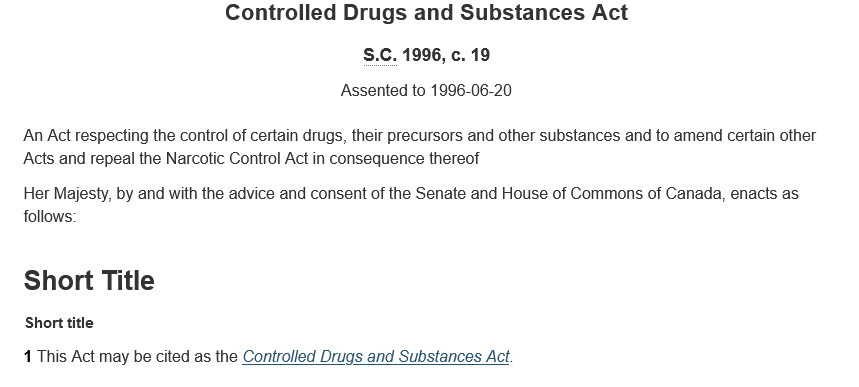3.1 Overview
Let’s start Chapter 3 with a little quiz

Who knew that a cup of coffee could be a work of art? A talented barista can make coffee look as good as it tastes. According to the Coffee Association of Canada, 2/3 of all Canadians drink at least one cup of coffee a day.[1] That is a lot of “jo”! If you are a coffee drinker, what is it about the coffee that you enjoy? Perhaps it is the heat of the beverage, which feels nice during our long Canadian winters. Maybe it is how it makes you feel? Coffee can make you more alert, and it may improve your concentration. That is because the caffeine in coffee is a psychoactive substance. In fact, “caffeine is the most widely consumed psychoactive substance in the world”. [2]Along with caffeine there are numerous other psychoactive substances, this is what we will explore next.
3.1A Activities
- Brainstorm a list of terms you have heard for psychoactive substances.
- Do you think psychoactive substances should be controlled? Why or why not?
What is a psychoactive substance (drug)? Psychoactive substances change the function of the brain and result in alterations of mood, thinking, perception, and/or behaviour. Psychoactive substances may be used for many purposes, including therapeutic, ritual/cultural, or recreational purposes. Psychoactive substances come in many forms and are identified in many ways. Uppers, downers, X, bennies, oxy or whatever street name you may have heard or use, these are all examples of what are commonly known as street drugs. In fact, when most people mention the word drug, they will think of street drugs. We use the term psychoactive substance or substance, rather than drug in this text. This is to reduce some of the stigma associated with the term “drug” or “drug user”.
There are many psychoactive substances you can purchase legally at your neighbourhood coffee spot or gas station, pharmacy, or local liquor store. What is the difference between these substances? Why are some psychoactive substances considered legal and others illegal? Why are some substances controlled and others not? This is where we will explore the various categories of psychoactive substances, look at where these substances come from, how they are made and how they can be obtained (prescription, over-the-counter, supplements, in a store, coffee spot, mini mart or on the street.
In Canada, psychoactive substances are controlled by the Controlled Drug and Substances Act (CDSA).

Health Canada administers the CDSA and its regulations to:
- allow access for lawful purposes;
- reduce the risk that controlled substances and precursors will be used for illegal purposes.[3]
Lawful purposes include using substances like aspirin or ibuprofen for aches and pains as well as any medication that may have been prescribed to you.
Food For Thought
- Do you think prescription medication is without risk? Why or why not?
- Why do you think some substances require a prescription?
Let’s check out the list below and take a look at some of the most commonly used psychoactive substances. You will note some of these substances are “scheduled” by the CDSA, which means they are controlled substances and are associated with laws in Canada. A controlled substance means a substance included in Schedule I, II, III, IV or V and except as authorized under the regulations, no person shall possess a substance included in Schedule I, II or III unless prescribed from a licensed physician.[4]
While you may dig deeper into the schedule of substances, for the purpose of this text the psychoactive substances we will explore have all been grouped into 5 categories based on their impact on the body, rather than their schedule according to the CDSA.[5]
Depressants
-
- Alcohol
- Barbiturates (schedule 4)
- GHB/Rohypnol (schedule 4)
Stimulants
-
-
- Caffeine
- Nicotine
- Cocaine (schedule 1)
- Amphetamine (schedule 1)
- Ecstasy (schedule 3)
-
Hallucinogens
-
-
-
- Psylocibin mushrooms (schedule 3)
- Cannabis
- LSD (schedule 3)
- Mescaline (schedule 3)
-
-
Opiates
-
- Morphine (schedule 1)
- Oxycodone (schedule 1)
- Fentanyl (schedule 1)
- Heroin (schedule 1)
- Carfentanil (schedule 1)
Psychotherapeutic agents
-
- Valium (schedule 4)
- Efexor (schedule 4)
- Anabolic steroids (schedule 4)
3.1B Activities
- Watch the following educational playlist from Bevel Up. https://www.nfb.ca/film/topics-street-drugs-101/
- What did you learn about methadone? Do you believe methadone can help everyone who uses opiates? Why or why not?
- What is one thing you learned about multi-substance use?
- Choose a category of psychoactive substances and become a subject matter expert (SME). Once you have learned everything you can about this category, choose another category. Compare and contrast categories and two substances in each category.
- What stood out to you?
- What do you want to know more about?
For more information on these substances and others, check out the Centre for Addiction and Mental Health.
Chapter Credit
Adapted from 8.8 Psychoactive Drugs by CK-12 Foundation contained in Human Biology by Christine Miller published by Thompson Rivers University. CC BY-NC . This unit is updated with new Canadian content.
Image Credits
- Cappucino Art by Drew Coffman / Unsplash License
- Government of Canada. (2021). Controlled drug and substances act [screenshot]. Justice Laws website. https://laws-lois.justice.gc.ca/eng/acts/c-38.8/
- Coffee Association of Canada. (2018). Coffee facts. https://coffeeassoc.com/coffee-facts/ ↵
- Centre for Addiction and Mental Health. (2021). Caffeine, (para. 12). https://www.camh.ca/en/health-info/mental-illness-and-addiction-index/caffeine ↵
- Government of Canada. (2021). Controlled drug and substances act. https://laws-lois.justice.gc.ca/eng/acts/c-38.8/ ↵
- Ibid. ↵
- Ibid. ↵

